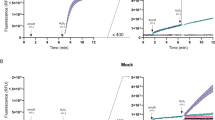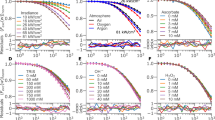Abstract
Low concentrations of reactive oxygen species, notably hydrogen peroxide (H2O2), mediate various signalling processes in the cell1,2. Production of these signals is highly regulated3 and a suitable probe is needed to measure these events. Here, we show that a probe based on a single nanoparticle can quantitatively measure transient H2O2 generation in living cells. The Y0.6Eu0.4VO4 nanoparticles undergo photoreduction under laser irradiation but re-oxidize in the presence of oxidants, leading to a recovery in luminescence. Our probe can be regenerated and reliably detects intracellular H2O2 with a 30-s temporal resolution and a dynamic range of 1–45 µM. The differences in the timing of intracellular H2O2 production triggered by different signals were also measured using these nanoparticles. Although the probe is not selective towards H2O2, in many signalling processes H2O2 is, however, the dominant oxidant3,4,5,6. In conjunction with appropriate controls, this probe is a powerful tool for unravelling pathways that involve reactive oxygen species.
This is a preview of subscription content, access via your institution
Access options
Subscribe to this journal
Receive 12 print issues and online access
$259.00 per year
only $21.58 per issue
Buy this article
- Purchase on Springer Link
- Instant access to full article PDF
Prices may be subject to local taxes which are calculated during checkout




Similar content being viewed by others
References
Rhee, S. G. H2O2, a necessary evil for cell signaling. Science 312, 1882–1883 (2006).
Bedard, K. & Krause, K.-H. The NOX family of ROS-generating NADPH oxidases: physiology and pathophysiology. Physiol. Rev. 87, 245–313 (2007).
D'Autréaux, B. & Toledano, M. B. ROS as signaling molecules: mechanisms that generate specificity in ROS homeostasis. Nature Rev. Mol. Cell Biol. 8, 813–824 (2007).
Sundaresan, M., Yu, Z.-X., Ferrans, V. J., Irani, K. & Finkel, T. Requirement for generation of H2O2 for platelet-derived growth factor signal transduction. Science 270, 296–299 (1995).
Bae, Y. S. et al. Epidermal growth factor (EGF)-induced generation of hydrogen peroxide. J. Biol. Chem. 272, 217–221 (1997).
Halliwell, B. & Cutteridge, J. M. C. Free Radicals in Biology and Medicine (Oxford Univ. Press, 1999).
Plonka, A. et al. Superoxide radical dismutation by copper proteins. J. Radioanal. Nucl. Chem. 101, 221–225 (1986).
Lambeth, J. D. NOx enzymes and the biology of reactive oxygen. Nature Rev. Immunol. 4, 181–189 (2004).
Clempus, R. E. & Griendling, K. K. Reactive oxygen species signaling in vascular smooth muscle cells. Cardiovasc. Res. 71, 216–225 (2006).
Paravicini, T. M. & Touyz, R. M. Redox signaling in hypertension. Cardiovasc. Res. 71, 247–258 (2006).
Chen, C. H. et al. Reactive oxygen species generation is involved in epidermal growth factor receptor transactivation through the transient oxidization of Src homology 2-containing tyrosine phosphatase in endothelin-1 signaling pathway in rat cardiac fibroblasts. Mol. Pharmacol. 69, 1347–1355 (2006).
Soh, N. Recent advances in fluorescent probes for the detection of reactive oxygen species. Anal. Bioanal. Chem. 386, 532–543 (2006).
Hempel, S. L., Buettner, G. R., O'Malley, Y. Q., Wessels, D. A. & Flaherty, D. M. Dihydrofluorescein diacetate is superior for detecting intracellular oxidants: comparison with 2′,7′-dichlorodihydrofluorescein diacetate, 5(and 6)-carboxy-2′,7′-dichlorodihydrofluorescein diacetate, and dihydrorhodamine 123. Free Radic. Biol. Med. 27, 146–159 (1999).
Miller, E. W., Albers, A. E., Pralle, A., Isacoff, E. Y. & Chang, C. J. Boronate-based fluorescent probes for imaging cellular hydrogen peroxide. J. Am. Chem. Soc. 127, 16652–16659 (2005).
Miller, E. W., Tulyathan, O., Isacoff, E. Y. & Chang, C. J. Molecular imaging of hydrogen peroxide produced for cell signaling. Nature Chem. Biol., 3 263–267 (2007).
Lee, D. et al. In vivo imaging of hydrogen peroxide with chemiluminescent nanoparticles. Nature Mater. 6, 765–769 (2007).
Seshiah, P. N. et al. Angiotensin II stimulation of NAD(P)H oxidase activity: upstream mediators. Circ. Res. 91, 406–413 (2002).
Wolfbeis, O. S., Duerkop, A., Wu, M. & Lin, Z. Europium ion-based luminescent sensing probe for hydrogen peroxide. Angew. Chem. Int. Ed. 41, 4495–4498 (2002).
Belousov, V. V. et al. Genetically encoded fluorescent indicator for intracellular hydrogen peroxide. Nature Meth. 3, 281–286 (2006).
Beaurepaire, E. et al. Functionalized fluorescent oxide nanoparticles: artificial toxins for sodium channel targeting and imaging at the single molecule level. Nano Lett. 4, 2079–2083 (2004).
Casanova, D., Giaume, D., Gacoin, T., Boilot, J.-P. & Alexandrou, A. Optical in situ size determination of single lanthanide-ion doped oxide nanoparticles. Appl. Phys. Lett. 89, 253103 (2006).
Dorenbos, P. Anomalous luminescence of Eu2+ and Yb2+ in inorganic compounds. J. Phys. Condens. Matt. 15, 2645–2665 (2003).
Sawyer, D. T. & Valentine, J. S. How super is superoxide? Acc. Chem. Res. 14, 393–400 (1981).
Hall, C. N. & Attwell, D. Assessing the physiological concentration and targets of nitric oxide in brain tissue. J. Physiol. 586, 3597–3615 (2008).
Chansel, D. et al. Heparin binding EGF is necessary for vasospastic response to endothelin. FASEB J. 20, E1368–E1381 (2006).
Rosenkranz, S. et al. Inhibition of the PDGF receptor by red wine flavonoids provides a molecular explanation for the ‘French paradox’. FASEB J. 16, 1958–1960 (2002).
Heumüller, S. et al. Apocynin is not an inhibitor of vascular NADPH oxidases but an antioxidant. Hypertension 51, 211–217 (2008).
Daub, H., Weiss, F. U., Wallasch, C. & Ullrich, A. Role of transactivation of the EGF receptor in signalling by G-protein-coupled receptors. Nature 379, 557–560 (1996).
Saito, Y., Haendeler, J., Hojo, Y., Yamamoto, K. & Berk, B. C. Receptor heterodimerization: essential mechanism for platelet-derived growth factor-induced epidermal growth factor receptor transactivation. Mol. Cell. Biol. 21, 6387–6394 (2001).
Casanova, D. et al. Counting the number of proteins coupled to single nanoparticles. J. Am. Chem. Soc. 129, 12592–12593 (2007).
Acknowledgements
We thank G. Mialon and M. Moreau for nanoparticle synthesis.
Author information
Authors and Affiliations
Contributions
D.C., C.B. and T.-L.N. contributed equally. D.C., C.B., P.-L.T. and A.A. conceived and designed the experiments. D.C., C.B. and T.-L.N. performed the experiments. D.C., C.B., T.-L.N. and A.A. analysed the data. R.O.R. and L.B.-S. contributed the cell cultures and data on nanoparticle toxicity. T.G. and J.-P.B. contributed the nanoparticles. All authors discussed the results. C.B. and A.A. co-wrote the paper.
Corresponding author
Supplementary information
Supplementary information
Supplementary information (PDF 970 kb)
Rights and permissions
About this article
Cite this article
Casanova, D., Bouzigues, C., Nguyên, TL. et al. Single europium-doped nanoparticles measure temporal pattern of reactive oxygen species production inside cells. Nature Nanotech 4, 581–585 (2009). https://doi.org/10.1038/nnano.2009.200
Received:
Accepted:
Published:
Issue Date:
DOI: https://doi.org/10.1038/nnano.2009.200
This article is cited by
-
Fabrication of meso- and macro-porous Y2WO6:Eu3+ phosphor thin films by Pechini-type sol–gel dip-coating method and their characteristic optical properties
Journal of Sol-Gel Science and Technology (2021)
-
ROS and diseases: role in metabolism and energy supply
Molecular and Cellular Biochemistry (2020)
-
Excimer Emission of Acridine Orange Adsorbed on Gadolinium-Yttrium Orthovanadate Nanoparticles
Journal of Fluorescence (2018)
-
Ultra-wide range field-dependent measurements of the relaxivity of Gd1−xEuxVO4 nanoparticle contrast agents using a mechanical sample-shuttling relaxometer
Scientific Reports (2017)
-
Facile and Chemically Pure Preparation of YVO4:Eu3+ Colloid with Novel Nanostructure via Laser Ablation in Water
Scientific Reports (2016)



